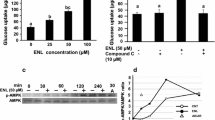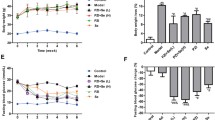Abstract
Selenium-enriched exopolysaccharides (EPS) produced by Enterobacter cloacae Z0206 have been proven to possess effect on reducing blood glucose level in diabetic mice. To investigate the specific mechanism, we studied the effects of oral supply with EPS on skeletal muscle glucose transportation and consumption in high-fat-diet-induced diabetic KKAy mice. We found that EPS supplementation increased expressions of glucose transporter 4 (Glut4), hexokinase 2 (hk2), phosphorylation of AMP-activated kinase subunit α2 (pAMPKα2), and peroxisome proliferator-activated receptor γ coactivator 1α (PGC-1α), and increased expression of characteristic protein of oxidative fibers such as troponin I and cytochrome c (Cytc). Furthermore, we found that EPS increased glucose uptake and expressions of pAMPKα2 and PGC-1α in palmitic acid (PA)-induced C2C12 cells. However, while EPS inhibited AMPKα2 with interference RNA (iRNA), effects of EPS on the improvement of glucose uptake diminished. These results indicated that EPS may improve skeletal muscle glucose uptake of diabetic KKAy mice through AMPKα2-PGC-1α pathway.




Similar content being viewed by others
References
Abel ED, Peroni O, Kim JK et al (2001) Adipose-selective targeting of the GLUT4 gene impairs insulin action in muscle and liver. Nature 409:729–733
Carling D (2004) The AMP-activated protein kinase cascade—a unifying system for energy control. Trends Biochem Sci 29:18–24
Chavez JA, Summers SA (2003) Characterizing the effects of saturated fatty acids on insulin signaling and ceramide and diacylglycerol accumulation in 3 T3-L1 adipocytes and C2Cl2 myotubes. Arch Biochem Biophys 419:101–109
Fu J, Fu J, Yuan J et al (2012) Anti-diabetic activities of Acanthopanax senticosus polysaccharide (ASP) in combination with metformin. Int J Biol Macromol 50:619–623
Henriksen EJ, Bourey RE, Rodnick KJ et al (1990) Glucose transporter protein content and glucose transport capacity in rat skeletal muscles. Am J Physiol 259:E593–E598
Hickey MS, Carey JO, Azevedo JL et al (1995) Skeletal muscle fiber composition is related to adiposity and in vitro glucose transport rate in humans. Am J Physiol Endocrinol Metab 268:E453–E457
Jager S, Handschin C, St-Pierre J et al (2007) AMP-activated protein kinase (AMPK) action in skeletal muscle via direct phosphorylation of PGC-1alpha. Proc Natl Acad Sci U S A 104:12017–12022
Jin M, Lu Z, Huang M et al (2012) Effects of Se-enriched polysaccharides produced by Enterobacter cloacae Z0206 on alloxan-induced diabetic mice. Int J Biol Macromol 50:348–352
Jin ML, Wang YM, Xu CL et al (2010) Preparation and biological activities of an exopolysaccharide produced by Enterobacter cloacae Z0206. Carbohydr Polym 81:607–611
Jorgensen SB, Treebak JT, Viollet B et al (2007) Role of AMPK alpha 2 in basal, training-, and AICAR-induced GLUT4, hexokinase II, and mitochondrial protein expression in mouse muscle. Am J Physiol Endocrinol Metab 292:E331–E339
LeBrasseur NK, Kelly M, Tsao TS et al (2006) Thiazolidinediones can rapidly activate AMP-activated protein kinase in mammalian tissues. Am J Physiol Endocrinol Metab 291:E175–E181
Leick L, Fentz J, Bienso RS et al (2010) PGC-1 alpha is required for AICAR-induced expression of GLUT4 and mitochondrial proteins in mouse skeletal muscle. Am J Physiol Endocrinol Metab 299:E456–E465
Lin J, Wu H, Tarr PT et al (2002) Transcriptional co-activator PGC-1 alpha drives the formation of slow-twitch muscle fibres. Nature 418:797–801
Liu J, Zhang JF, Lu JZ et al (2013) Astragalus polysaccharide stimulates glucose uptake in L6 myotubes through AMPK activation and AS160/TBC1D4 phosphorylation. Acta Pharmacol Sin 34:137–145
Lowell BB, Shulman GI (2005) Mitochondrial dysfunction and type 2 diabetes. Science 307:384–387
Michael LF, Wu ZD, Cheatham RB et al (2001) Restoration of insulin-sensitive glucose transporter (GLUT4) gene expression in muscle cells by the transcriptional coactivator PGC-1. Proc Natl Acad Sci U S A 98:3820–3825
Ojuka EO (2004) Role of calcium and AMP kinase in the regulation of mitochondrial biogenesis and GLUT4 levels in muscle. Proc Nutr Soc 63:275–278
Patti ME, Butte AJ, Crunkhorn S et al (2003) Coordinated reduction of genes of oxidative metabolism in humans with insulin resistance and diabetes: Potential role of PGC1 and NRF1. Proc Natl Acad Sci U S A 100:8466–8471
Schiaffino S, Sandri M, Murgia M (2007) Activity-dependent signaling pathways controlling muscle diversity and plasticity. Physiology 22:269–278
Shepherd PR, Kahn BB (1999) Mechanisms of disease—glucose transporters and insulin action—implications for insulin resistance and diabetes mellitus. New Engl J Med 341:248–257
Sletmoen M, Maurstad G, Sikorski P et al (2003) Characterisation of bacterial polysaccharides: steps towards single-molecular studies. Carbohydr Res 338:2459–2475
Steinberg GR, Watt MJ, Mcgee SL et al (2006) Reduced glycogen availability is associated with increased AMPK alpha 2 activity, nuclear AMPK alpha 2 protein abundance, and GLUT4 mRNA expression in contracting human skeletal muscle. Appl Physiol Nutr Metab-Physiol Appl Nutr Metab 31:302–312
Suwa M, Egashira T, Nakano H et al (2006) Metformin increases the PGC-1 alpha protein and oxidative enzyme activities possibly via AMPK phosphorylation in skeletal muscle in vivo. J Appl Physiol 101:1685–1692
Tang Z, Gao H, Wang S et al (2013) Hypolipidemic and antioxidant properties of a polysaccharide fraction from Enteromorpha prolifera. Int J Biol Macromol 58:186–189
Veciana-Nogues MT, Izquierdo-Pulido M, Vidal-Carou MC (1997) Determination of ATP related compounds in fresh and canned tuna fish by HPLC. Food Chem 59:467–472
Xu CL, Wang YZ, Jin ML et al (2009) Preparation, characterization and immunomodulatory activity of selenium-enriched exopolysaccharide produced by bacterium Enterobacter cloacae Z0206. Bioresour Technol 100:2095–2097
Yoshioka K, Takahashi H, Homma T et al (1996) A novel fluorescent derivative of glucose applicable to the assessment of glucose uptake activity of Escherichia coli. Biochim Biophys Acta 1289:5–9
Zhou G, Myers R, Li Y et al (2001) Role of AMP-activated protein kinase in mechanism of metformin action. J Clin Invest 108:1167–1174
Zhu K, Nie S, Li C et al (2013) A newly identified polysaccharide from Ganoderma atrum attenuates hyperglycemia and hyperlipidemia. Int J Biol Macromol 57:142–150
Zou F, Mao XQ, Wang N et al (2009) Astragalus polysaccharides alleviates glucose toxicity and restores glucose homeostasis in diabetic states via activation of AMPK. Acta Pharmacol Sin 30:1607–1615
Acknowledgments
This work was financially supported by National Basic Research Program of China (Grant No. 2012CB124705) and the Modern Agro-industry Technology Research System (No. CARS-36).
Author information
Authors and Affiliations
Corresponding author
Rights and permissions
About this article
Cite this article
Zhou, X., Chen, J., Wang, F. et al. Selenium-enriched exopolysaccharides improve skeletal muscle glucose uptake of diabetic KKAy mice via AMPK pathway. J Physiol Biochem 70, 547–554 (2014). https://doi.org/10.1007/s13105-014-0334-3
Received:
Accepted:
Published:
Issue Date:
DOI: https://doi.org/10.1007/s13105-014-0334-3




